Past Winners
Past WinnersDevice to Diagnose Bladder Cancer
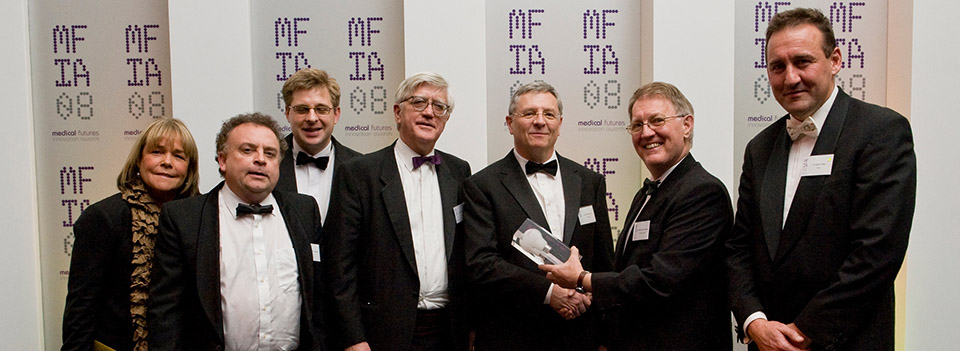
Dr. Nick Miller-Jones and Lawrence Fenelon, UroSens Ltd, Cambridge
Overall winner of The Cancer Innovation Awards 2008
This is a point of care test for diagnosing bladder cancer. It detects the presence of a special protein, a marker for bladder cancer in a urine sample. The main current method for diagnosing bladder cancer is cystoscopy, which involves passing an endoscope up the urethra and into the bladder under anaesthetic. The new test will be much cheaper, is non-invasive, and hopes to save many patients the need for a cystoscopy. Bladder cancer is the fifth most common cancer with high level of recurrence. The team hope that the test could be used to monitor cancer patients and check for recurrence and in the long run, possibly become a screening tool. The test is undergoing clinical trials and should be available in two to three years.
Judges Comments: The underlying technology behind this innovation won a previous Medical Futures Award and they are delighted to now see it find clinical utility. They are keen to see this enter into clinical trials, and if positive, they believe it could drastically change the management of this serious disease.
VideoMediSoft - an electronic patient records system for eye departments
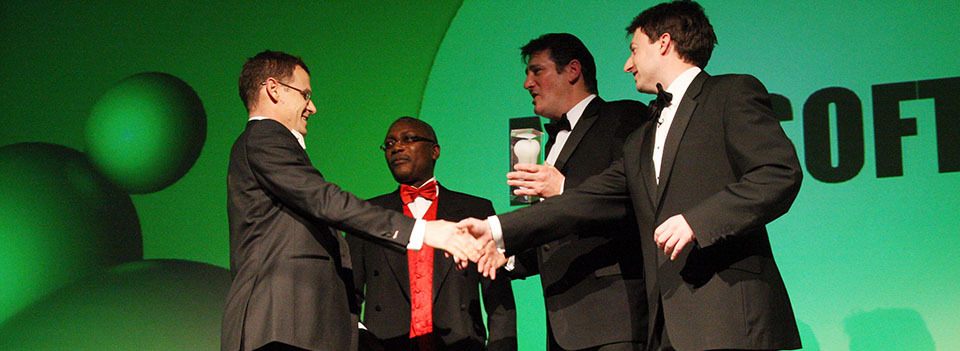
Robert Johnston Consultant Ophthalmologist, Gloucestershire Hospitals NHS Foundation Trust, Medical Director Medisoft Limited and David Johnston, CEO Medisoft Limited.
Overall Winner in the Ophthalmology Innovation Awards 2008
An Ophthalmology doctor has developed an electronic patient records system for eye departments. The system was set up to overcome the frustrations of not being able to access the outcomes of operations and other difficulties surrounding paper based notes. The system captures all of the required information around surgery and outpatient appointments. The system also includes information on glaucoma and diabetic eye disease. A company, Medisoft has been formed and in less than eight years the team have managed to go from a standing start to covering almost all of the eye departments in the UK that have electronic patient records. Medisoft is carrying out a pilot to test the feasibility of paperless eye departments and have ambitious growth plans.
Judges Comments: The Judges felt this was an exemplar as to how electronic records should be developed, from the bottom up with clinical and technical collaboration, to exacting standards. They felt that the team have the potential to create a national database for ophthalmology.
VideoCell Therapy to Improve Cardiac Repair
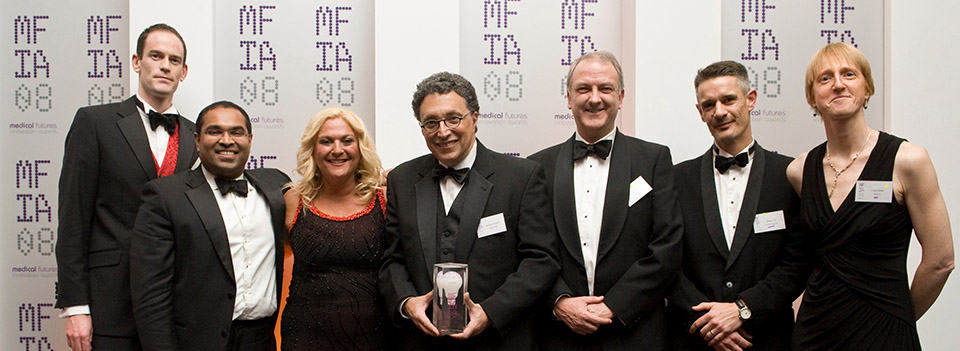
Michael Schneider, Dorian Haskard, and Ranil de Silva, National Heart and Lung Institute, Imperial College London
Overall Winner in the Cardiovascular Innovation Awards 2008
This new technique uses heart stem cells to repair the damage to the cardiac muscle caused by heart disease and heart attacks. In a heart attack, heart muscle cells die but existing treatments don't repair the damage to the muscle and have a limited effect on heart function. Professor Schneider was among the first to show that stem or progenitor cells exist in heart muscle, and then developed techniques to purify progenitor cells from a patient's heart and grow them in the laboratory. The Imperial College team proposes to graft the human cells into injured cardiac muscle, under clinically relevant conditions, to obtain the safety and efficacy data needed to justify a phase I human trial. The team is seeking funding to support this essential bridge to clinical evaluation.
Judges Comments: The judges felt that whilst there are many inherent risks with such early stage research, this is exactly the kind of translational research which should be funded as its potential impact is significant.
VideoInfraRed Dental Imaging

Dr Christopher Longbottom, Prof John Girkin, Prof Nigel Pitts and Dr Simon Poland, Dundee University and Strathclyde University
Overall Winner of the Dentistry and Oral Health & NHS Technology Innovation Awards 2008
This is a medical device that will enable dentists to produce images of teeth, bones and gums similar to X-rays using Infrared light. The team have developed the instrument using a miniature camera and a set of tiny mirrors to produce images of the teeth but without the risks associated with X-rays, especially in children. The idea came about through collaboration between physicists and dentists and the hope is to enable dentists to monitor teeth and bones over time. InfraRed Imaging potentially has much wider application for example, in measuring bone density. The team is currently testing out their device in the laboratory and they are seeking funding to develop and test a clinical instrument.
Judges Comments: The Judges were highly impressed by the potential of this technology and wish to see it progress and obtain proof of concept
VideoHand Held Hearing Tests
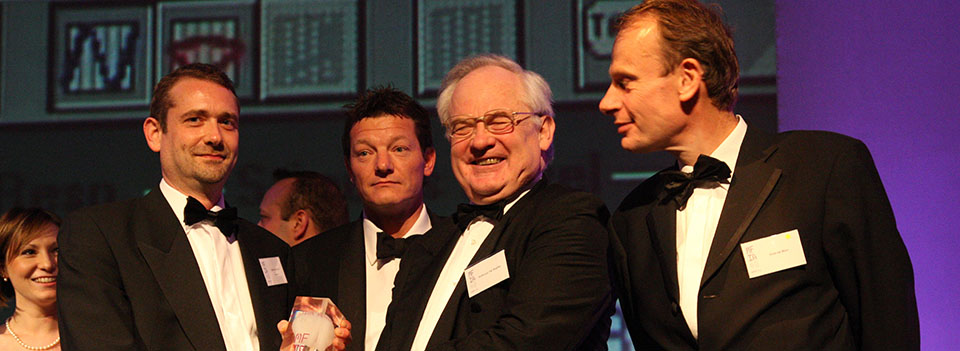
Mr Jonathan Scotchbrook, Martin Simpson, Gary Norman, Sensaurial Ltd, Oxford
Overall Winner of the ENT & Audiology Innovation Awards 2008
This is a medical device to improve the diagnosis of hearing loss. Every person has a specific hearing profile, however techniques currently used to measure hearing are limited, measuring only eight frequency points. They also require a large hospital based laboratory, and can take up to half an hour to complete. A company from Oxford is developing a much simpler, hand-held device that uses technology to measure hundreds of frequencies in less than 30 seconds. Pre-clinical trials have been very positive and the team are now looking for funding to commence clinical trials, with the aim of having a market ready device by the end of 2009.
Judges Comments: The Judges felt this was a very exciting concept that needs to go through appropriate clinical trials, and if positive, they would like to see this brought to the market in the shortest possible time
VideoInjectable Bone
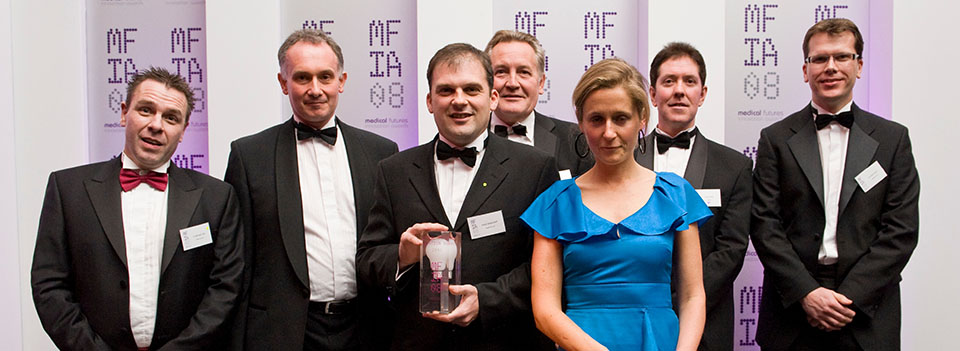
Professor Kevin Shakesheff, University of Nottingham, Michael Leek, Cheryl Hunter, and Helen Cox, Regentec Ltd, Nottingham
Overall Winner of the Orthopaedic Innovation Awards 2008
This is a polymer technology to make a liquid bone for use as bone graft during surgery. A team of scientists from Nottingham have developed a synthetic, biodegradable material which has the texture of toothpaste but when injected into the body hardens within 15 minutes, at body temperature and has similar characteristics to normal bone. Approximately 1.5 million bone graft procedures are performed annually worldwide. Many of these require bone to be taken from other parts of the body, or from other donors. Although there are many other synthetic materials on the market, they are difficult to shape and the new ‘injectable bone' is a much simpler procedure, allowing bone voids to be filled with ease. The material is biodegradable allowing new bone to replace it gradually. The team are seeking funding to carry out clinical trials.
Judges Comments: The Judges felt that this was a platform technology with significant clinical utility. They particularly liked the fact that it did not heat up when inserted into the body like many other injectable substances. They would like to see this enter into clinical trials.
VideoThe Moorfields Motion Displacement Test (MDT) for Glaucoma Detection
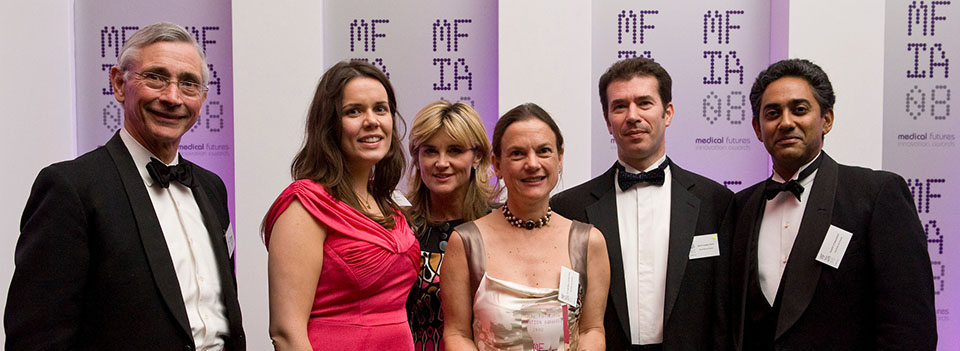
Mr. David Garway-Heath, Dr. Gay Mary Verdon-Roe, Mr. Ananth Viswanathan, and Professor Fred Fitzke, Moorfields Eye Hospital and the UCL Institute of Ophthalmology
Overall Winner of the MRC Translational Research Innovation Awards 2008
The Moorfields motion displacement test (MDT) is a software program for assessing the field of vision to detect glaucoma. The aim of the test is to tackle the global challenge of undiagnosed glaucoma. The MDT runs on a laptop computer and offers the advantages of portability, affordability and potential accessibility through the internet. The latest test strategy, developed with City University, London, takes 90 seconds per eye and is currently undergoing validation with three international centres. The team seeks to commercialise the technology on completion of the validation program in 2009. Future plans include the development of a paediatric version of the test in collaboration with Great Ormond Street Hospital, London.
Judges Comments: The panel believed that if the multi-centre trials prove positive, that this could be an exciting tool with commercial utility and would like to see a robust implementation plan developed especially one that looks at reimbursement in the US.
VideoPersonalised Cancer Medicines
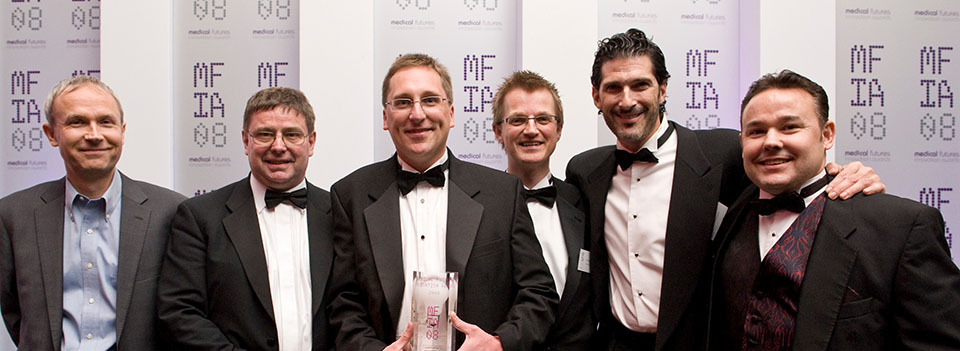
Dr. Christopher Torrance, Professor Alberto Bardelli, Dr. Darrin, M Disley, Dr. Rob Howes, and Dr. Paul Morrill, Horizon Discovery Ltd, Cambridge
Overall winner of the Best Business Innovation Awards 2008
Horizon Discovery is a company developing next-generation medicines designed to individual patient needs. Horizon's patented GENESIS™ technology has enabled the creation of more than 100 human cell lines that model how cancer 'looks' genetically in different patient populations. The development of a drug can take 15 years and cost more than £500m. X-MAN™ models enable pharmaceutical companies to 'dramatically' short-cut the drug development process and predict success or failure at a much earlier stage, potentially saving the companies hundreds of millions of pounds. A recent drug for lung cancer was found to only work in 10% of patients, a result that the Horizon technology could have predicted years before it entered clinical trials. Despite being a start-up, Horizon Discovery is profitable and is already taking equity positions in exciting fast growing therapeutic companies.
Judges Comments: The Judges welcomed this as a breakthrough that could speed up the process of drug discovery and in the process help many patients from having to take drugs that may not work for them. They would like to see pharmaceutical companies and regulators embrace the concept of personalised medicine.
VideoProstate Cancer MRI Scan
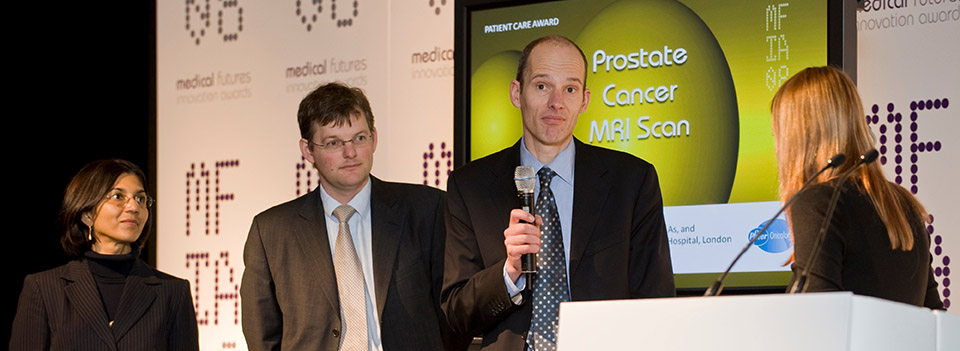
Dr Chris Parker, Dr Nick Van As, and Professor Mandita De Souza, Royal Marsden Hospital, London
Winner of a Patient Care Innovation Award Care in the Cancer Innovation Awards
This technology concept uses a special MRI scan of the prostate in an attempt to distinguish between harmful and harmless prostate cancers, and so reduce the need for biopsies.
A blood test called prostate specific antigen or PSA is currently used to test for prostate cancer, and men with high PSA levels may then require a biopsy to check for cancer. Many prostate cancers are very slow growing, and even if detected, may never cause the patients any symptoms in their lifetime and hence certain patients are being treated unnecessarily.
The technology has been tested in a pilot study of 86 men. Initial results suggest that the number of men undergoing biopsy could be reduced by half with no impact on the detection of harmful prostate cancers. The team is now seeking funding to carry out more detailed trials.
Judges Comments: The Judges felt that this project demonstrated beautifully how technology could be used to improve service design and patient care and would like to see it developed further.
Cancer Diagnosis at the Speed of Light
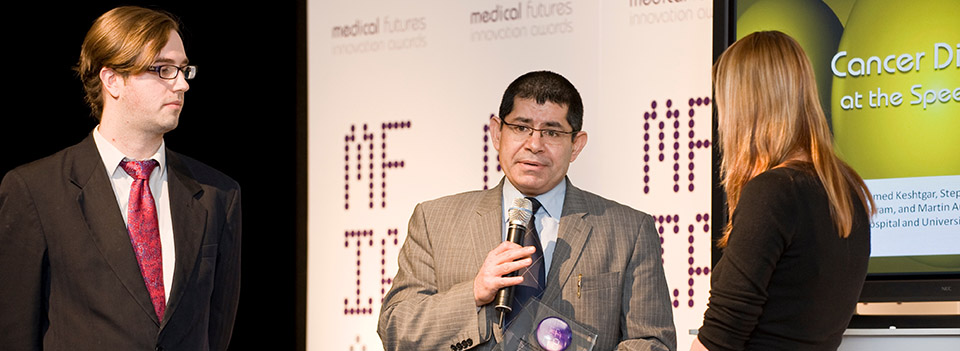
Mohammed Keshtgar, Stephen G Bown, Santosh Somasundaram, and Martin Austwick
Winner of Best Diagnostic Technology in the Cancer Innovation Awards
This is a medical device to speed up the diagnosis of breast cancer. During surgery, a lymph gland, called the sentinel node is taken from the armpit and sent to the laboratory to check for spread. If the gland is positive then the patient may be recalled for a second operation. A team from London has developed an optical scanner that can be used in operating theatres at the time of surgery. If positive, definitive surgery takes place there and then, saving up to a third of women the need to undergo a second operation. Unlike some other available methods, the lymph gland is not destroyed and so can be sent to the laboratory for further tests. The technology relies on light and elastic scattering spectroscopy that displays different optical signature between cancer and non cancerous cells.
Judges Comments: Whilst this is a very crowded space, it was felt that low cost and the fact that the sample was not destroyed were major benefits over competitive technologies. The Judges would like to see this project progress into a multi-centred trial.
PACEMAX - Optimising Pacemakers
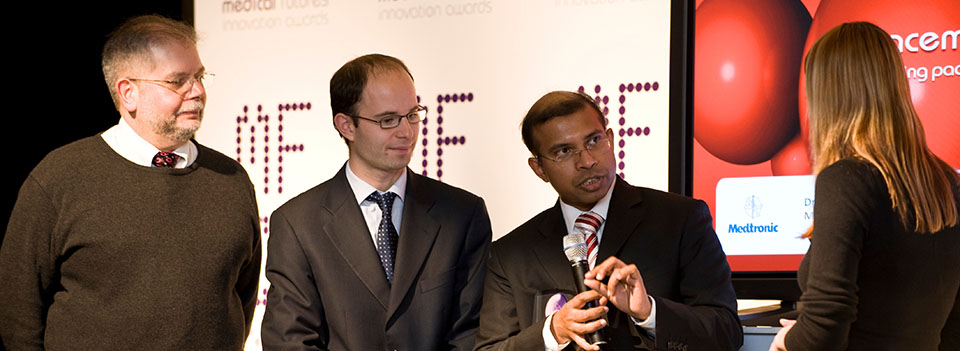
Dr. Darrel Francis, Dr. Zachary Whinnett, and Mr. Keith Willson, Imperial College London
Winner of Best Technology in the Cardiovascular Innovation Awards
This is a new form of software using special algorithms to optimise the timings on a heart pacemaker so that it accurately mimics the contractions of the patient’s heart. Currently available techniques used to determine the optimal settings for pacemakers are unreliable, uncomfortable for the patient, time consuming and expensive. The new technology synchronises the pacemaker much more accurately and in just a few minutes and could be a bit like the “automatic fine tuning” button that improves pictures on analogue televisions. The technology aims to benefit patients by increasing their exercise capacity and reducing breathlessness. The team is looking to validate the technique and is seeking partnerships with device manufacturers.
Judges Comments: This Judges felt this was an exciting development, but that it would be difficult to commercialise as a stand alone entity and are therefore keen to promote dialogue with relevant device manufacturers.
Biomimetic Coating for Vascular Access Grafts
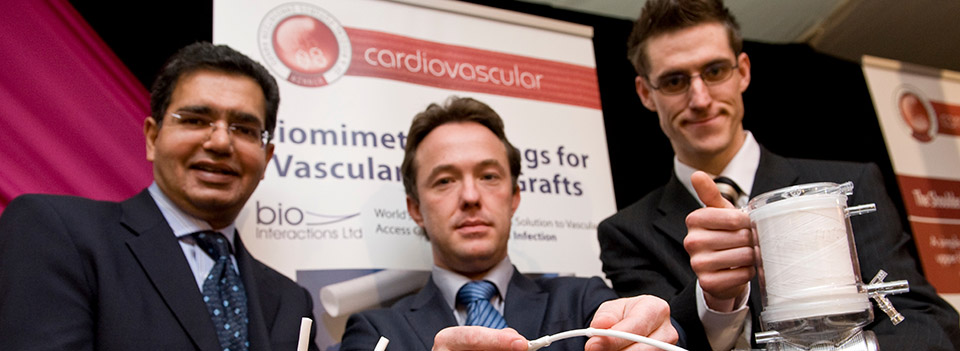
Dr. Shiv Sandhu, Simon Onis and Alan Rhodes of BioInteractions Ltd, Reading, Berkshire
Winner of a Best Biotechnology Award in the Cardiovascular Innovation Awards
This biomaterials technology aims to reduce the rate of complications associated with dialysis. In patients with kidney failure, a tubular graft is implanted under the skin to connect an artery to a vein. This graft provides specialists with an access point to perform efficient dialysis. Complications relating to graft placement, repeated puncture and the presence of an artificial conduit can lead to complications including blood clots and infection. This team from Berkshire has developed new innovative coatings, derived from proven technologies. These proprietary technologies mimic components of the natural artery to render the graft infection free and free flowing for dialysis.The developers are seeking funding for clinical trials to enable the technology to benefit patients within three years.
Judges Comments: The Judges felt that this technology addressed a major unmet need, in that complications relating to infections and thrombosis of grafts cost the NHS significant sums. They would like to see this technology progressed into clinical trials.
SIGHT-SIM
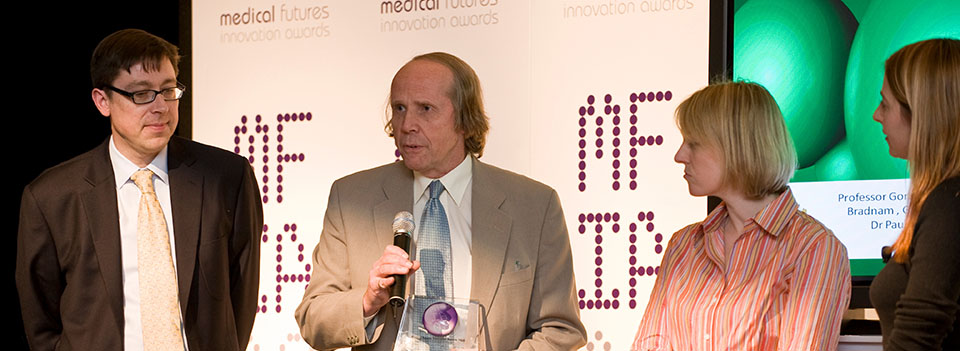
Professor Gordon Dutton, Dr Ruth Hamilton and Dr Michael Bradnam, Greater Glasgow & Clyde Health Board and Dr Paul Siebert, University of Glasgow
Winner of the Best Education Award in the Ophthalmology Innovation Awards
This is new software to help parents, teachers, carers and fellow pupils to visualise how sight impaired children see the world.
A child’s visual acuity and other measurements are entered into a software programme and a digital photograph, for example of a teddy bear, is modified to enable the user to see the same image as they do. The technology could have wider applications, for use in elderly people with visual impairment and to help manufacturers, publishers and advertisers better understand their markets, for example by adjusting the colours or print size on books or on packaging.
A prototype has been developed and tested with support from the Chief Scientist Office, and funding is now required to commercialise it.
Judges Comments: The Judges felt that this was a vast improvement on existing products on the market trying to do similar things, and they felt that funded and exploited through the appropriate channels, this could have significant impact.
Intelligent Breathing
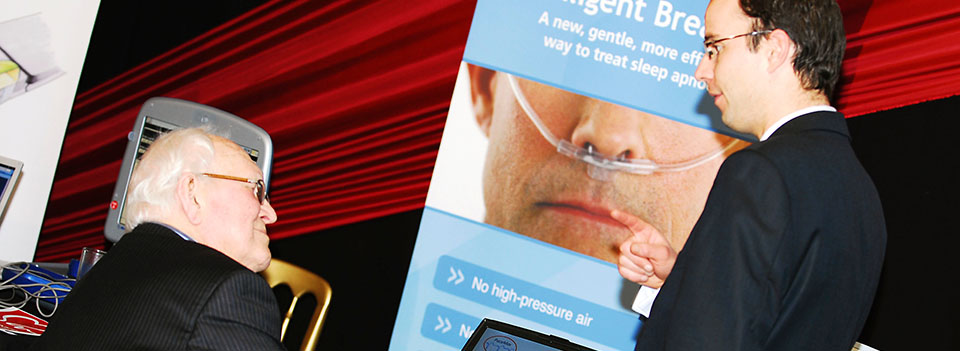
Dr. Darrell Francis, Dr. Charlotte Manistey, Mr Keith Wilson & Dr. Resham Baruah, Imperial College London
Commended in the Cardiovascular Innovation Awards
This is a new device to help those suffering from sleep apnoea. Unlike cumbersome masks that are used for sleep apnoea, the new technology predicts apnoeas before they occur, and prevents them with a tiny, carefully-timed, dose of Carbon Dioxide (a natural gas present in the lungs) which forces the patient to breathe.
Shoulder Lifter for Cardiac Surgery
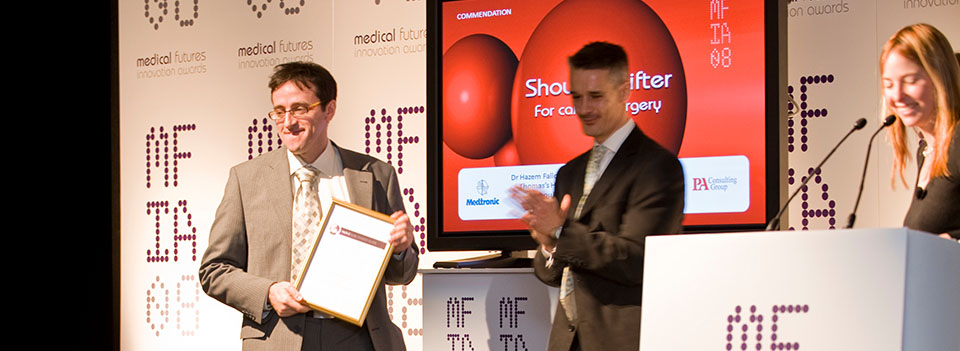
Dr. Mazam Fallouh & Dr. David Chambers, St Thomas's Hospital, London
Commended in the Cardiovascular Innovation Awards
A new device to help lift the patients shoulders when undergoing open heart surgery. To get into the chest cavity the breast bone needs to be split and when this is put back together again is under a lot of tension. The new device helps reduce the tension and make closure easier and safer for the patient.
Electro-Elution
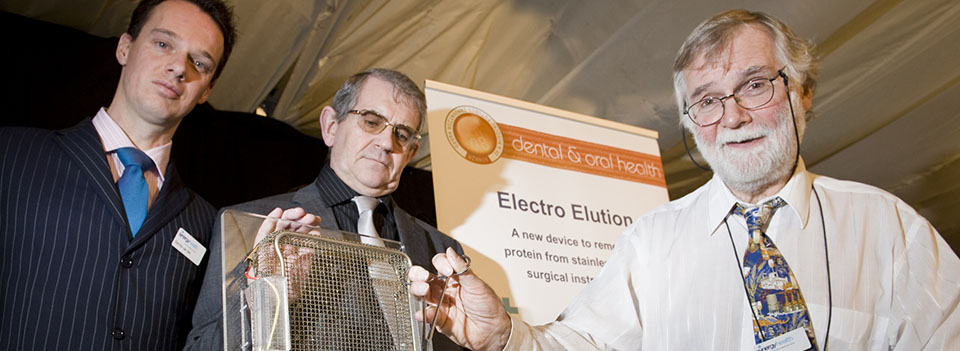
Dr Frank Prior, Robert Smith, Dr. Adrian Coward, Synergy Health, Strathclyde, Scotland
Winner of a Patient Safety Innovation Award in the Dentistry & Oral Health Innovation Awards
Electro-elution is a new cleaning method for stainless steel surgical instruments using electrolysis. It removes blood protein and bacteria much faster than traditional methods and also removes prion protein the agent believed to cause Creutzfeldt Jacob Disease (CJD). The method uses a standard basket that is used to clean surgical instruments, but it is negatively charged.
Most proteins, including prions, are negatively charged and are therefore repelled off the surface of the instrument into the electrolyte where they are broken down, rendering them inactive. The team has developed a working prototype and has gathered much clinical evidence. They are in the process of licensing negotiations to start manufacturing.
Judges Comments: The Judges felt this was a novel idea and although initially tested in dentistry, they believed could have much wider application and want to see this progress into clinical trials.
Plaque Revealed
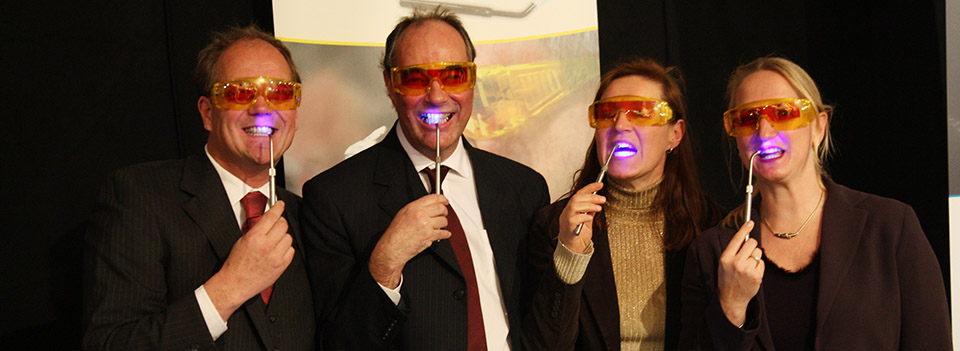
University of Liverpool
Commended in the Dental & Oral Health Innovation Awards
This is a special blue light that when shone onto teeth can reveal plaque. Unlike disclosing tablets the light leaves no marks on the teeth and can only be seen when the light is shone on the teeth. The aim is to produce a toothbrush that contains the light and when a child has finished brushing their teeth, they will be able to look for plaque themselves.
International Virtual Dental School (IVIDENT)
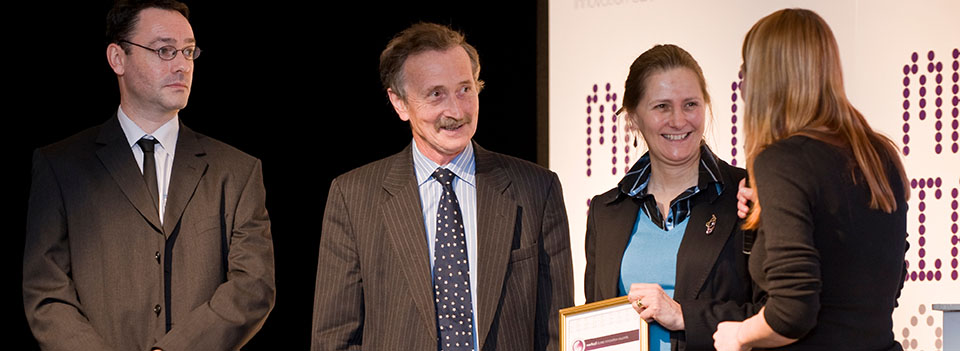
Kings College London
Commended in the Dental & Oral Health Innovation Awards
IVIDENT aims to provide high quality, accessible, innovative and exciting dental education through a flexible online environment. Funded by HEFCE (Higher Education Funding Council for England) and the Department of Health, this three year educational research project aims to become a self-sustaining non-profit making enterprise.
Immuno-therapeutic Prevention of Dental Decay
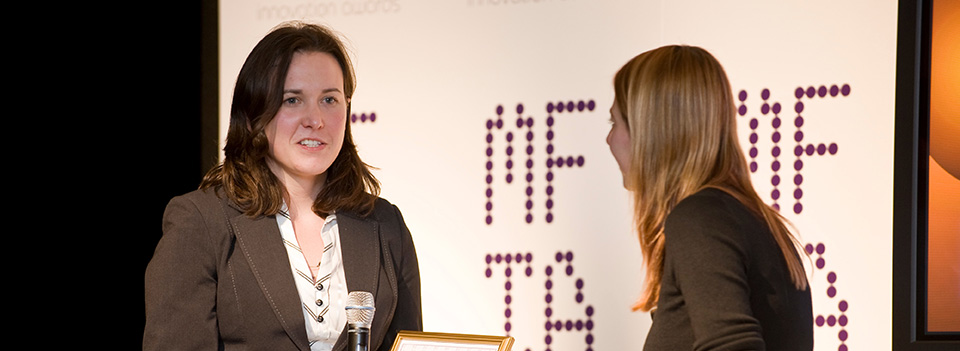
Dr Shauna Culshaw, University of Glasgow & Martin Taubmam, The Forsyth Institute, Boston
Commended in the Dental & Oral Health Innovation Awards
This is a concept stage targeted therapeutic to reduce dental decay or caries, a major problem for society, especially for children in deprived areas. This team has built a program to develop a vaccine for dental caries. They aim to identify proteins mediating immunity, which prevent the accumulation of caries-causing mutans streptococci in the oral bacterial biofilm, a bacteria proposed to be one of the major causes of dental caries especially in children. Although the work remains at a research stage, it is hoped that funding will be found to take the project forwards into manufacturing, clinical trials and ultimately to market.
Judges Comments: The Judges were supportive of this work, providing that a mechanism was found to ensure that vaccination reached those that needed it most and the team could demonstrate a health economic model of cost effectiveness.
An Ear Worn Sensor for Remote Healthcare Management
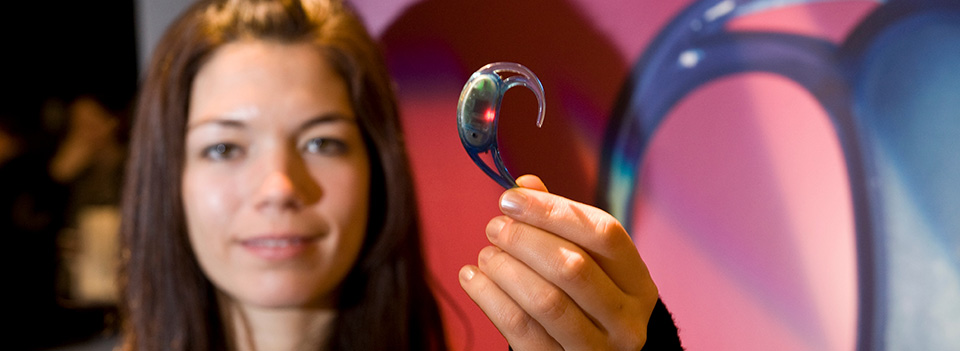
Professor Guang-Zhong Yang, Dr Benny Lo, and Dr Louis Atallah, Imperial College, London
Winner of a Translational Research Award in the ENT & Audiology Innovation Awards
This is a medical device that is capable of detecting and recording information on a person’s movement and activity. It could transform the rehabilitation of surgical or stroke patients by enabling healthcare professionals to monitor a patient’s mobility and whether there is swaying or imbalance. It also has potential application in the care of the elderly. The device, which fits neatly behind the patient’s ear, processes information in real time, and transmits it to a remote database. The technology has been in development for four years and clinical trials have been carried out. A spin out company, Sensixa is now seeking funding to commercialise the device.
Judges Comments: The Judges felt that this was an exciting platform technology and recommend that the team focus on finding the right clinical applications and develop robust routes to market.
Laryngeal Laser Surgery Trainer
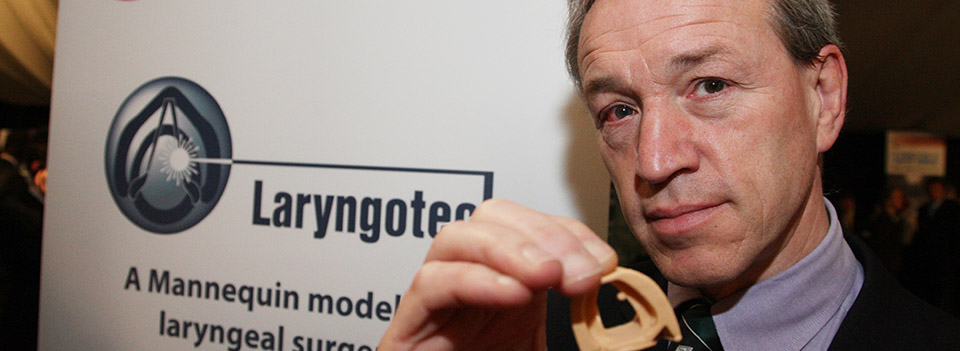
Meredydd Harries and Anne Cureton, Royal Sussex County Hospital, West Sussex
Winner of a Surgical Training Innovation Award in the ENT & Audiology Innovation Awards
This is an innovative training tool to improve laryngeal surgical skills using a mannequin model. Trainees in laryngeal surgery currently have to learn by direct supervision at live surgery.
A surgeon from West Sussex has spent over two years developing a model of a head and neck with vocal cord inserts that slot into the appropriate position in the mannequin. He experimented with numerous materials before he found one that mimics the characteristics of normal and diseased vocal cords, for example, with polyps or cancers. His model allows trainee surgeons to practice and be tested in both microinstrumentation and laser techniques before they operate on patients.
This teaching tool has been validated, and they are seeking funding to make it widely available.
Judges Comments: The model will allow trainers to monitor trainee’s progress and improve patient care. Although they believe that computer simulation models are likely to be the future, this model has significant current utility and is at the forefront of innovation in ENT training.
Retinal Oximetry using Hyperspectral Imaging
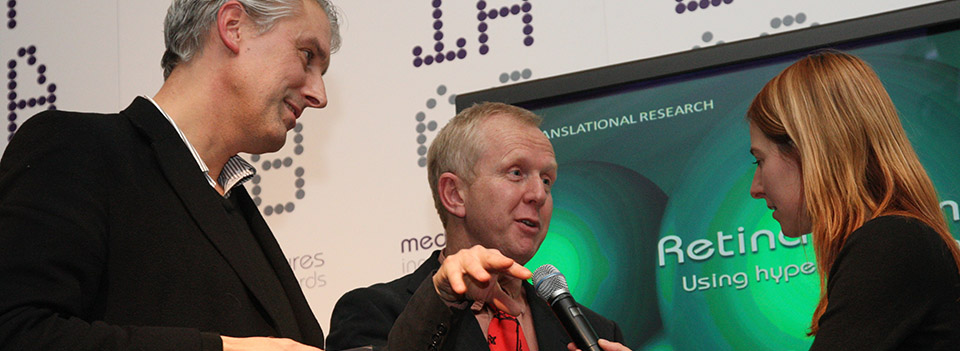
Andrew McNaught: Gloucestershire Hospitals NHS Foundation Trust, Cheltenham and Andy Harvey, Heriot-Watt University, Edinburgh
Winner of Best Translational Research in the Ophthalmology Innovation Awards
This is an imaging device, and analysis software, that can quantify the oxygen saturation in blood vessels in the retina at back of the eye. The new technique uses hyperspectral imaging, and will help in the detection, and management of eye disease such as diabetic retinopathy, glaucoma and macular degeneration. The ‘IRIS’ technology was originally developed for defence applications in association with Qinetiq. The new technology is non invasive and a vast improvement over current methods which involve an injection of dye into the blood vessels. It could potentially be used as a screening tool in diabetic retinopathy, and also to determine the extent of nerve damage in glaucoma. The team is looking to commercialise the product.
Judges Comments: The Judges felt this was exciting research and would like to see it further validated in clinical situations and for it to be brought to the market so that it can benefit patients.
The Mini Slitlamp
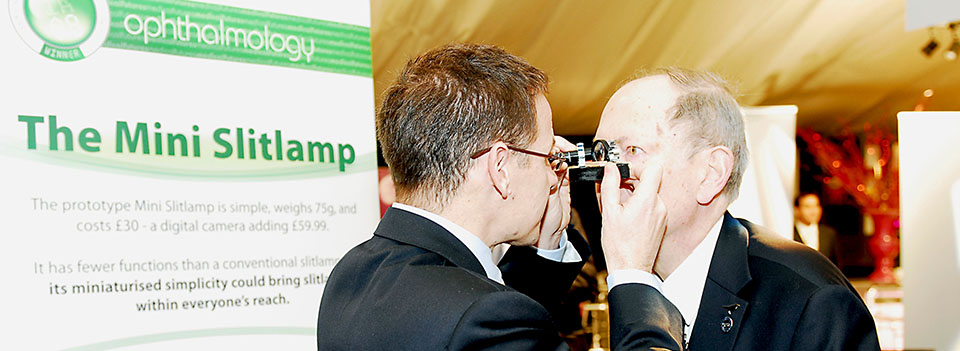
Mr Roger H Armour, Retired Surgeon, Hertfordshire
Winner of Best Medical Device in the Ophthalmology Innovation Awards
This is a handheld medical device used to examine the front of the eye and detect diseases such as acute glaucoma and cataracts. Slit lamps have been around for over 100 years but are large and complicated and cost up to £10,000, whereas Armour’s invention is a much simpler, miniature version and costs only £100. It works in a similar way to the original slit lamp, by illuminating a section of the eye which can then be seen in very small detail. It even has a digital camera to record pictures. Its size and affordability aims to make the product much more accessible by GP’s, medical students and healthcare workers in developing countries, and improve the pick up of sight threatening diseases such as acute glaucoma. Roger now hopes to turn his home-made prototype into a market ready device.
Judges Comments: The Judges previously gave an Award to Mr Armour in 2003 for a lens free ophthalmoscope which has since reached the market. They are keen to see his next invention similarly benefit patients.
RetVas, The Diagnostic Retinal Image Quantification Tool
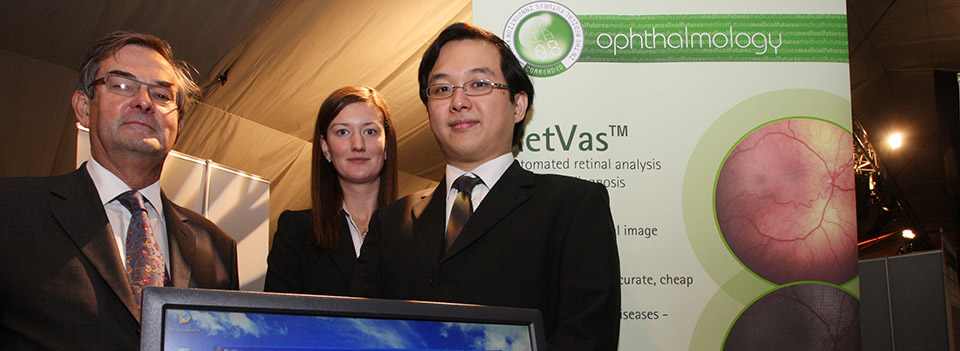
Kings College, Imperial College London and City University
Commended in the Ophthalmology Innovation Awards
Technology software to screen for eye disease of the newborn and diabetic retinopathy.
Dignified Living - The Clip & Pull
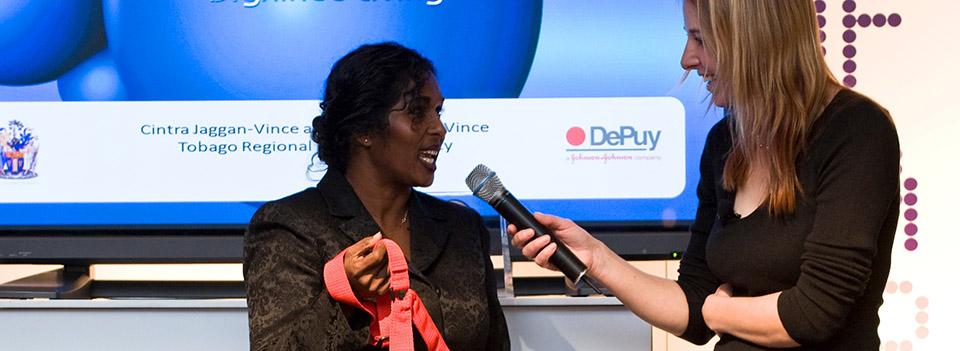
Cintra Jaggan-Vince and Dr. Jonathan Vince, Tobago Regional Health Authority
Winner of a Patient Care Award in the Orthopaedic Innovation Awards
This is a device that helps to restore independence to people with disability. The device, developed by a nurse, arose when she was having difficulty getting dressed due to back pain, and her child suggested that she invent something to help her. After three and a half years of working on various designs, testing them out on family and friends, the first Clip and Pull Device, was developed. It has a special patented clip which has a very strong grip, but opens with a very gentle squeeze mechanism so that it can be used by people with arthritis. Once the clips are attached to clothes the user can pull up their underwear or trousers and zip up a jacket with ease. The product is currently being manufactured and sold in small numbers.
Judges Comments: The Judges felt that the clip mechanism was ingenious as it requires no power of grip to apply and so would be great help for suffers of stroke, arthritis or loss of a limb. They would like to see the inventor be given assistance to make this widely available.
Electro Spinning for Orthopaedic Implants
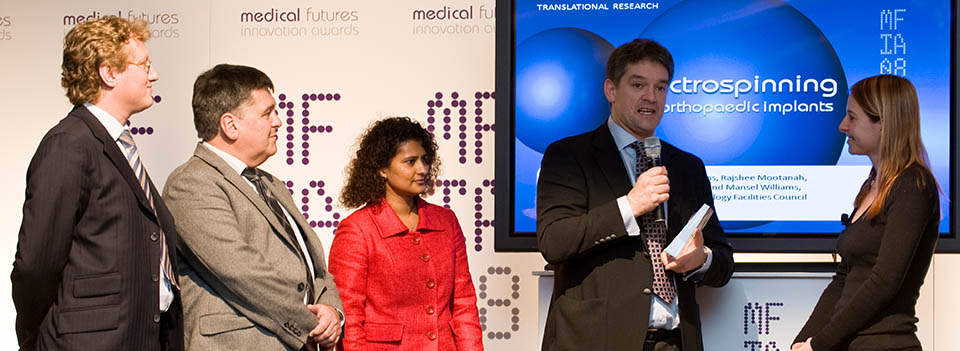
Dr Robert Stevens, Rajshee Mootanah, Julian Fairman, and Mansel Williams, Oxfordshire
Winner of a Translational Research Award in the Orthopaedic Innovation Awards
This is a nanotechnology coating technique to modify the surface of implants and create a ‘living interface’ between artificial implants and bone. This space-age technology adds micro and nano sized hair like structures to the surface which relieve stress on the implant. In addition there is the possibility of adding a multilayer coating containing biological substances, such as growth factors that can improve attachment. The technology is being spun out from the Science and Technology Facilities Council and although only at a concept stage for medical applications, feasibility studies have begun to develop a nanofibres coatings which can be applied to hip implants. This is a platform technology, which has a wide number of clinical applications and the team are looking for clinical collaborations to solve unmet needs.
Judges Comments: The Judges felt that this was a very exciting development that could have wide clinical application, in particular in spinal surgery. They would like to see the team develop clinical partners and progress this further.
FRIEND - Fracture Healing Monitor
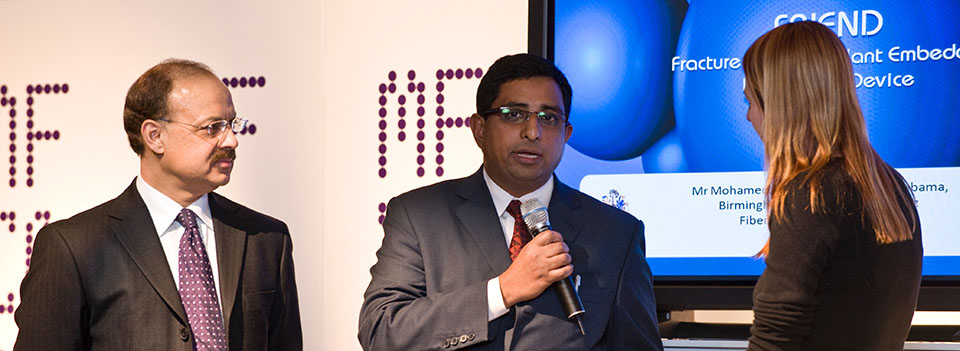
Mohamed Khalid, City Hospital, Birmingham & Shafiq Parwaz, Fiberlogix International Limited, Middlesex
Winner of Best Blue Sky Idea in the Orthopaedic Innovation Awards
The Fracture Repair Implant Embedded Navigation Device or FRIEND is a medical device to detect movement in healing fractures. If a fracture has healed or fusion has taken place, there should be no movement. Surgeons are guided by X-ray appearances and patient symptoms but in some circumstances it is very difficult to tell when union has taken place. This new fibre optic wire technology can be embedded within orthopaedic implants or in healing bones to look for micro movements and help orthopaedic surgeons determine how well a fracture is healing and also to guide weight bearing. The team have to date carried out basic proof of concept work but are now looking for funding to take this to market.
Judges Comments:The judges felt this could be a very useful clinical research tool but and within certain clinical situations such as spine surgery could have huge clinical utility.

